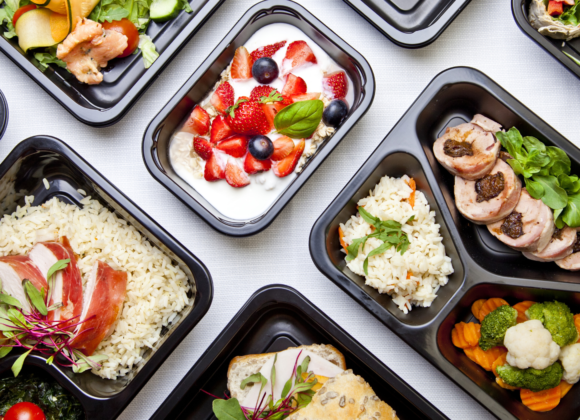Wzrost świadomości oraz rozwijający się kult zdrowego trybu życia spowodował wzrost zainteresowania konsumentów żywnością wygodną. Konsumenci oczekują od producentów żywności wygodnej, łatwej w przygotowaniu o odpowiedniej wartości odżywczej i odpowiednich walorach sensorycznych. Pojęcie żywność wygodna pochodzi od angielskiego wyrażenia „convenience food” i oznacza grupę produktów spożywczych, które w wyniku odpowiedniego przetworzenia umożliwiają szybkie i łatwe przygotowanie ich do spożycia.
Do żywności wygodnej zalicza się produkty, które nadają się do spożycia po krótkim i łatwym przygotowaniu. Są to produkty gotowe do bezpośredniego spożycia lub wymagające niewielkiej obróbki kulinarnej, porcjowane i zapakowane z dbałością o najwyższy komfort konsumenta. Do tej grupy żywności zaliczamy zarówno produkty wysoko przetworzone (np. zupy instant) jak i produkty minimalnie przetworzone (np. surówki i sałatki). Żywność wygodną dzieli się na podgrupy produktów (pod względem gotowości do spożycia):
- Ready to Process – produkty gotowe do obróbki wstępnej;
- Ready to Kitchen – produkty gotowe do obróbki kulinarnej;
- Ready to Cook – produkty gotowe do obróbki termicznej;
- Ready to Heat – produkty gotowe do podgrzania;
- Ready to Eat – produkty gotowe do spożycia.
Większa aktywność zawodowa kobiet, powiększająca się liczba gospodarstw domowych jedno i dwuosobowych, brak czasu na samodzielne przygotowywanie posiłków w domu, zwiększone spożycie posiłków poza domem powoduje, że rynek żywności wygodnej dynamicznie wzrasta. Szczególnie spożycie sałatek i surówek. Produkty te bazują na świeżych surowcach (kiełki, świeże warzywa i owoce) i uznawane są przez konsumentów za bezpieczne i korzystne dla zdrowia, a ich spożycie z roku na rok wzrasta.
źródło: pixabay
Zagrożenia mikrobiologiczne w żywności typu ready to eat
Zgodnie z definicją Międzynarodowej Komisji ds. Wymagań Mikrobiologicznych dla Żywności (ICMSF), są to nieakceptowane zanieczyszczenia, wzrost lub przeżywalność drobnoustrojów w żywności, które mogłyby spowodować jej zepsucie lub wytwarzanie i utrzymywanie się w niej toksyn, enzymów, amin biogennych bądź produktów ich metabolizmu.
Monitorowanie jakości mikrobiologicznej żywności gotowej do spożycia, zwłaszcza żywności, która nie jest poddawana obróbce termicznej (np. surówki i sałatki) jest niezwykle ważna. Dostarcza informacji o higienie procesu produkcji i dystrybucji oraz potencjalnych nieprawidłowościach technologicznych. Przy produktach spożywczych gotowych do spożycia (np. surówki i sałatki albo przekąski warzywne) ryzyko związane z zanieczyszczeniami mikrobiologicznymi jest wysokie. Obecność niektórych mikroorganizmów może powodować zatrucia, zakażenia pokarmowe, a w skrajnych przypadkach prowadzi do śmierci. Przez wiele lat za główną przyczynę zatruć pokarmowych uznawano bakterie z rodzaju: Salmonella, Clostridium, Staphylococus, Eschericha i Pseudomonas. Obecnie szczególnym zainteresowaniem cieszą się nowe czynniki chorobotwórcze, do których zaliczamy bakterie z rodzaju m.in. Listeria monocytogenes. Źródłem zanieczyszczeń mikrobiologicznych żywności ready to eat może być: gleba, insekty, zwierzęta oraz zanieczyszczenia pojawiające się podczas procesu produkcji i przechowywania.
Listeria monocytogenes
Źródłem bakterii Listeria monocytogenes w żywności typu ready to eat są najczęściej sery produkowane z niepasteryzowanego mleka, mięso i jego przetwory oraz warzywa i sałatki składające się z surowych warzyw. Sałata, szpinak, kalafior, kapusta, seler i brokuł oraz wszystkie surówki i sałatki pakowane w modyfikowanej atmosferze określa się jako szczególnie narażone na zanieczyszczenie tym patogenem. W wielu badaniach naukowych opisano występowanie Listeria monocytogenes w surówkach i sałatkach. Szczególnie tych, w których występował ser lub mięso.
Pałeczki Listeria monocytoegenes po raz pierwszy zostały opisane przez Murraya w 1926 roku. Pierwsze udokumentowane przypadki zachorowań na listeriozę przenoszoną drogą pokarmową odnotowano w 1981 roku w Kanadzie. Doszło do zakażenia 7 osób dorosłych i 34 dzieci. Źródłem zakażenia okazała się kapusta wykorzystywana do produkcji sałatki colesław. Obecnie ponad 99% przypadków zachorowań na listeriozę u ludzi spowodowane jest spożyciem zanieczyszczonej żywności. W pierwszym półroczu 2023 roku liczba zanotowanych przypadków listeriozy wyniosła 75. W 2022 roku stwierdzono 29 przypadków choroby. Śmiertelność zakażeń wynosi 30%.
Listeria monocytogenes przekracza bariery ochronne organizmu człowieka: barierę krew-mózg, jelitową, łożyskową. Pierwsze objawy zakażenia występują po 24-48 godzinach od wniknięcia bakterii. Początkowe objawy zakażenia to: ból głowy i stawów oraz biegunka. Występuje senność i ogólne osłabienie. Przy wniknięciu większej liczby bakterii pojawia się ostry nieżyt żołądka i jelit. Objawy zwykle ustępują samoistnie, jednak u osób z grupy podwyższonego ryzyka (kobiety w ciąży, seniorzy, niemowlęta, osoby po przeszczepie lub chorobie nowotworowej) dochodzi do listeriozy, która może mieć różny przebieg. W wyniku listeriozy może dojść do bakteriemii, zapalenia opon mózgowo-rdzeniowych, zapalenia wsierdzia, zapalenia spojówek, zakażenia skóry. Listerioza jest szczególnie niebezpieczna dla kobiet w ciąży. Może powodować zakażenie płodu, prowadzić do poronienia, urodzenia martwego dziecka.
Ze względu na duże zagrożenie i wysoką śmiertelność związaną z infekcją bakterią L. monocytogenes listerioza podlega obligatoryjnej rejestracji– zgodnie z ustawą z dnia 5 grudnia 2008 roku o zapobieganiu oraz zwalczaniu zakażeń i chorób zakaźnych u ludzi. W Unii Europejskiej jest możliwa szybka wymiana informacji na temat zanieczyszczonej żywności dzięki Systemowi Wczesnego Ostrzegania o Niebezpiecznej Żywności i Paszach (RASFF – Rapid Alert System for Food and Feed ).
źródło: pixabay
Jak zapobiegać listeriozie?
Przede wszystkim należy kontrolować temperaturę przechowywania żywności gotowej do spożycia – nie powinna ona przekraczać 4 °C. Należy kupować produkty od sprawdzonego dostawcy. Kobiety w ciąży nie powinny spożywać niepasteryzowanego mleka, potraw długo przechowywanych w lodówce, potraw mięsnych podawanych na zimno, surowych ryb i owoców morza. Należy utrzymywać czystość – myć ręce przed przygotowywaniem oraz mycie rąk przed spożyciem pokarmu, utrzymanie w czystości miejscach przygotowywania żywności. Nie należy przechowywać żywności surowej razem z żywnością ugotowaną/ żywnością gotową do spożycia.












 Młodszy specjalista ds. komunikacji marketingowej i PR.
Młodszy specjalista ds. komunikacji marketingowej i PR.


 Absolwent Uniwersytetu Warszawskiego oraz Szkoły Głównej Gospodarstwa Wiejskiego. W branży HoReCa od ponad 10 lat. Przez lata związany z Grupą Trip, Sobienie Królewskie Golf and Country Club oraz restauracją Florentin w Warszawe.
Absolwent Uniwersytetu Warszawskiego oraz Szkoły Głównej Gospodarstwa Wiejskiego. W branży HoReCa od ponad 10 lat. Przez lata związany z Grupą Trip, Sobienie Królewskie Golf and Country Club oraz restauracją Florentin w Warszawe. Absolwentka Wydziału Architektury Politechniki Warszawskiej na kierunku Architecture for Society of Knowledge oraz Komunikacji Wizualnej na Politecnico di Milano. Specjalistka od budowania nastroju. Doświadczenie zdobywała w kraju i zagranicą podczas licznych warsztatów międzynarodowych (Sevilla, Lizbona, Florencja), stypendium na La Sapienza (Rzym) oraz pracując m.in. w Carmi e Ubertis i ADM Milano.
Absolwentka Wydziału Architektury Politechniki Warszawskiej na kierunku Architecture for Society of Knowledge oraz Komunikacji Wizualnej na Politecnico di Milano. Specjalistka od budowania nastroju. Doświadczenie zdobywała w kraju i zagranicą podczas licznych warsztatów międzynarodowych (Sevilla, Lizbona, Florencja), stypendium na La Sapienza (Rzym) oraz pracując m.in. w Carmi e Ubertis i ADM Milano.








 Menedżer z wieloletnim doświadczeniem w branżach kosmetycznej, spożywczej, dziecięcej. W trakcie swojej kariery związany z firmami takimi jak: L’Oreal, Samsung, Danone-Nutricia, Unilever. W ciągu swojego życia zawodowego odpowiadał między innymi za rozwój sprzedaży i contentu eCommerce w Polsce i krajach Europy Środkowo-Wschodniej.
Menedżer z wieloletnim doświadczeniem w branżach kosmetycznej, spożywczej, dziecięcej. W trakcie swojej kariery związany z firmami takimi jak: L’Oreal, Samsung, Danone-Nutricia, Unilever. W ciągu swojego życia zawodowego odpowiadał między innymi za rozwój sprzedaży i contentu eCommerce w Polsce i krajach Europy Środkowo-Wschodniej. 

























































